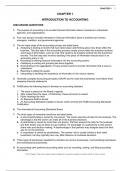Exam (elaborations)
Solution Manual For College Accounting, 24th Edition by 2025 by James A. Heintz, Robert W. Parry Chapter 1-27
- Course
- Institution
Solution Manual For College Accounting, 24th Edition by 2025 by James A. Heintz, Robert W. Parry Chapter 1-27
[Show more]



